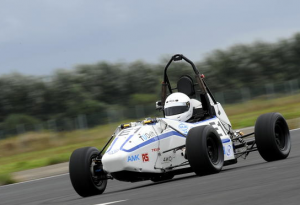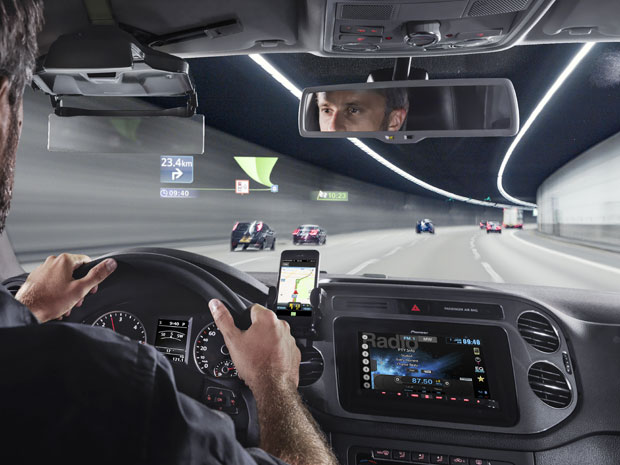In a laboratory on Norway’s fjord-laced coast, Jane Feste bubbles some carbon dioxide gas through a liquid for a crowd of visitors. “I will take an amine—that’s a base—and that will absorb…the CO2. So [that’s] what’s happening out in the plant, just shown for the eye here,” the laboratory technician explains. She’s referring to Technology Centre Mongstad (TCM), the US $1 billion, 350-megawatt power plant and test facility that the Norwegian government and several energy firms built. The assembled journalists cannot seem to decide if they should applaud the spectacle or if they’re witnessing a modern case of the emperor’s new clothes. Continue reading Inside the World’s Largest Carbon-Capture Test Facility
Category Archives: News
Dutch Students Break Electric Car Acceleration Record
 Dutch students today shaved 20 percent off the record time for an electric car to reach 100 km/h. The Delft University of Technology Racing Team first prepared the ground by blow-torching the rain-soaked runway at Valkenburg Airport, says team manager Tim de Morée, and sweetened the deal by drizzling a little sugar-water on the strip. “Drag racers use actual glue,” he said when questioned about the sportsmanship of the tactic.
Dutch students today shaved 20 percent off the record time for an electric car to reach 100 km/h. The Delft University of Technology Racing Team first prepared the ground by blow-torching the rain-soaked runway at Valkenburg Airport, says team manager Tim de Morée, and sweetened the deal by drizzling a little sugar-water on the strip. “Drag racers use actual glue,” he said when questioned about the sportsmanship of the tactic.
The car, driven by the team’s lightest member, Marly Kuijpers, repeated the run about ten times. The team tweaked the traction control and tire slippage for each run. The Dutch press declared victory when the car hit 100 km/h in 2.15 seconds, but de Morée told IEEE Spectrum that a later run achieved the target speed in 2.13 seconds.
Read the rest of this blog post at IEEE Spectrum’s Tech Talk blog: [html] [pdf]
The Race To Get Your Hands Off The Wheel
 A fleet of cars and drivers whisks visiting journalists around the Frankfurt Motor Show’s sprawling, 144-hectare site. Judging by the number of exhibits of self-driving car technology this year, future visitors can expect their courtesy cars to lack drivers. It’s a matter of putting together many existing technologies in an affordable, safe system.
A fleet of cars and drivers whisks visiting journalists around the Frankfurt Motor Show’s sprawling, 144-hectare site. Judging by the number of exhibits of self-driving car technology this year, future visitors can expect their courtesy cars to lack drivers. It’s a matter of putting together many existing technologies in an affordable, safe system.
One piece of that future system nearly clobbered a two-dimensional cutout of a child last week on a fenced-off piece of asphalt outside Hall 10. There, Bosch employees led by Werner Uhler were demonstrating a stereo optical camera system Uhler says could be cheaper than combined radar and optical systems used for collision avoidance today. The device is mounted on the front window of a testbed car, adjacent to the rear-view mirror. As the testbed approached a parked car, Uhler, seated in the backseat, said, “We will drive along…and suddenly a child will turn up and we will brake.”
Read the rest of this post at IEEE Spectrum’s Tech Talk blog: [html] [pdf]
Head Up Displays Go Down Market
 Heads Up Displays (HUDs), once the domain of fighter pilots and luxury car drivers, now come in a clip-on variety affordable to a much wider market. The systems project information on to a see-through screen to help keep their users’ attention outside the vehicle. But until now, such clarity of mind never came cheap: BMW charges over US $1000 for its built-in HUD system.
Heads Up Displays (HUDs), once the domain of fighter pilots and luxury car drivers, now come in a clip-on variety affordable to a much wider market. The systems project information on to a see-through screen to help keep their users’ attention outside the vehicle. But until now, such clarity of mind never came cheap: BMW charges over US $1000 for its built-in HUD system.
At this week’s Frankfurt Motor Show in Germany, several cheaper alternatives were on offer. Car accessory maker Pioneer showed off its NavGate HUD, which it will sell in Europe starting in October. The HUD uses Texas Instruments’ DLP projector instead of the more expensive laser found in a Japanese-market predecessor. That move shaves a few hundred dollars off its cost, but it still comes through at €699, or $927. Navigation system maker Garmin last month announced a dashboard-mounted HUD display for $150.
Unlike built-in HUDs systems, these after-market versions require drivers to provide a smartphone and to download separate applications (an additional $50 in Garmin’s case). But the ubiquity of smartphones is helping accessory makers to nip at the heels of car manufacturers in yet another product range. And for the DIYers, there’s always Lifehacker.
Read the rest of this blog post at IEEE Spectrum’s Tech Talk: [html] [pdf]

